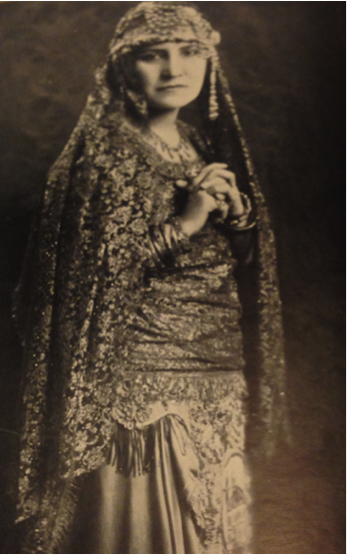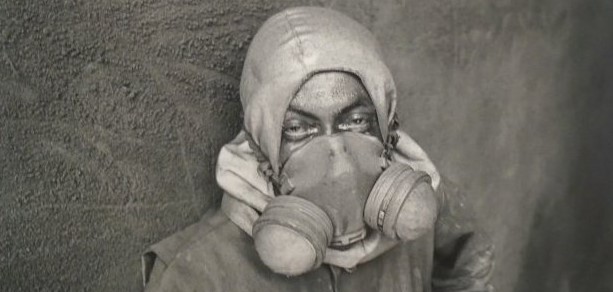Rahme Haidar – The Writer
This post is written by Amanda Eads, a Sociolinguistics student at NC State University. We published Part I of this series, Rahme Haidar-The Performer last week. Her previous writing includes a 3-part series on language and Lebanese identity. You can read Part I, Part II, and Part III on from the archives.

Arab American literature began at the end of the nineteenth century with the establishment of the first Arabic Newspaper Kawkab Amirka [Planet America] in 1892 [1]. When discussing the origins of Arab American literature names such as Gibran Khalil Gibran, Ameen Rihani, Abraham Rihbany, Mikhail Nai’my and even ‘Afifa Karam spring to mind given their popularity within the early Syrian community and its newspapers. However, the name Rahme Haidar is rarely mentioned even though she was quite well known in lecture circuits throughout the US. Haidar’s autobiography, Under Syrian Stars, was inspired by her time on the lecture circuit and written while she sojourned in Lebanon during 1928. While the work provides more detail about the Holy Land than the life of the Princess, it does exhibit the same self-orientalization and cultural mediation that was common among the Mahjar writers.
Like Gibran, Haidar used American Orientalism in her work although her ideas of homeland and holy land were less blurred than his. She begins her preface as follows:
“The motive for writing this book is three-fold; in the first place, I desire to record on the leaves of this tablet an accurate narrative and deeper insight into that mysterious and most wonderful land of the Saviour, to entertain, and to inspire. The experiences of my public life upon the lecture platform have afforded me the tastes and desires of the Western minds.
Many requests have come to me to prepare an edition recording my intimate knowledge of the land of my birth, its people, their manners, and customs, ideals and aspirations, from eminent divines, pastors of leading denominations, and outstanding scholars. I have yielded to these requests because I was born, reared and educated in an atmosphere permeated with biblical lore; for it is only by a native that the East can be rightly portrayed [2, emphasis added by author].”
In the first two paragraphs, she admits one of her key purposes for writing was to act as a cultural mediator in order to to satisfy the “tastes and desires of the Western minds” concerning the land of her birth- Greater Syria. In claiming “it is only by a native that the East can be rightly portrayed,” Haidar is subscribing to Orientalism by creating a dichotomy between East and West. She positions herself as an educated Christian Oriental when describing how she was raised thus aligning herself with the east meanwhile distancing herself from the non-Western, non-Christian and non-educated Syrians. Haidar along with other Arab American writers like Rihani and Rihbany used self-orientalization in order to mediate between the two cultures. The way Haidar constructed her discourse shows she intended to align herself as an Eastern Holy Land representative and as an educated Western Protestant Christian. While she never explicitly claims a race for herself, she used Christian identity to align herself with her white audience and used terminology that aligned the native inhabitants of the Holy Land as ‘other’ which was a common trope among early Arab American writers.

Haidar’s intentions of succumbing to American Orientalism are evident, however her intentions concerning the production of her nativity leave room for questioning. Swati Rana [3] defines immigrant nativity as “the production of belonging by immigrants.” Rana finds that both Rihani and Rihbany use the tradition of “Anglo-American Protestantism and literary transcendentalism” to claim a re-birth in the United States. Haidar also claims a re-birth in the U.S. through education and the protestant religion but this re-birth actually takes place in Syria before migrating to the U.S. Haidar describes growing up in Baalbek and following the customs of her people until her father developed a friendship with an American missionary-educator who eventually convinced her father to let her go to the American Missionary School in Sidon. She describes her experience once at the American missionary school:
“There, for the first time, I came in contact with the Western world, its people and their modes of living. There, after deep and careful study of the Word, and after a long struggle with the burden of my sins, I came face to face with the questions, ‘Where are you going to spend eternity?’ My people sent me there purposely for further education, but there, at the ancient Sidon was revealed to me the highest and deepest meaning of education; namely to increase one’s capacity to know God and to make Him known to others. For after all, is not this the great purpose of education and life? For to know Him and His son, Jesus Christ, is a life eternal.
During my course at Sidon, I often pictured the beauties of the new land- not only a land of liberty, but a land of opportunity, and the desire to sail forth to its shores grew keener and keener. I had become enamoured with everything Occidental [2]”.
Through this excerpt it becomes clear that Haidar uses her American education and her conversion to Christianity in order to position herself as American. Rana describes this re-birth experience as a way of “going native” and allowing the immigrant to claim the “heir to exceptional promise of America [3]”. Through the excerpt, Haidar transitions from her come-to-Jesus moment in “ancient Sidon” directly into a desire to experience the United States.
![Figure 3: Princess Rahme Haidar’s signature (Tatler 1926) [4].](https://lebanesestudies.ncsu.edu/wp-content/uploads/sites/16/2016/03/Writer-3.png)
While this clearly aligns her with the US, throughout other parts of her writing Haidar wrestles with the production of belonging. She describes herself as “what we call in America a Methodo-Bapto-Presby-Congregationo [2]” because of her combined experiences in different education systems. She attended Congregationalist services in Baalbek as a child before attending the Presbyterian missionary school in Sidon. Upon migration to the U.S. she obtained a bachelor degree from a Baptist Seminary in Ohio and then finished her schooling with a post-graduate degree in public speaking from the University of Southern California, which had heavy Methodist influence. Each of the identities she referenced are Christian but perhaps the fact that she used “Congregationo” as the base term of her religious identity could highlight her struggle to navigate between her two worlds. She uses communal pronouns like “we”, and “our” to align herself with both the U.S. as well as the Holy Land thus constructing an in-between identity. Like Rihbany, Haidar uses her old world nativity in the Holy Land to navigate the new nativity in the U.S. Not only is she using Orientalism in similar ways as the male Mahjar writers she is also portraying the same struggles with production of nativity. Because of the parallels between Haidar’s Under Syrian Stars and prominent Arab American writers such as Ameen Rihani and Abraham Rihbany, it becomes evident that Haidar has been overlooked in the early Arab American canon.
While she is widely mentioned in local newspapers and she performed in numerous venues, there is little to no mention of her within the Arab American community and no record of Princess Rahme Haidar performing for a specifically Arab American church or social event. Was she overlooked because she was excluded from the Arab American community? Or because she was a female writer and performer in a time when it was not socially acceptable for her to do so? Or perhaps because she wrote in English instead of Arabic like Afifa? Maybe she has been overlooked because of her obvious yielding to American Orientalism or as Michael Suleiman says her use of religion “as an escape”[5]? It is not clear why she has been given hardly any attention, but it is clear she had similar struggles with migration as other early Arab Americans and her work situates itself among the other early Arab American classic writers.
Sources
[1] Khater, A. (2005). “Becoming “Syrian” in America: A Global Geography of Ethnicity and Nation.” Diaspora 14(2/3): 299-331.
[2] Haidar, R. (1929). Under Syrian Stars. Fleming H. Revell Company: New York.
[3] Rana, S. (2011). “The Production of Nativity in Early Syrian Immigrant Literature” in American Literature 83(3): 547-570. Duke University Press: doi: 10.1215/00029831-1339863
[4] Tatler, The. (1926). Ed. Margaret Louise Newhall. Ebook produced by Williams, A. et al.
[5] Suleiman, MW. (1996). “The Arab-American Left” in Buhle, P. & Georgakas, D. eds. The Immigrant Left in the United States. State University of New York Press: Albany, NY.
- Categories:


